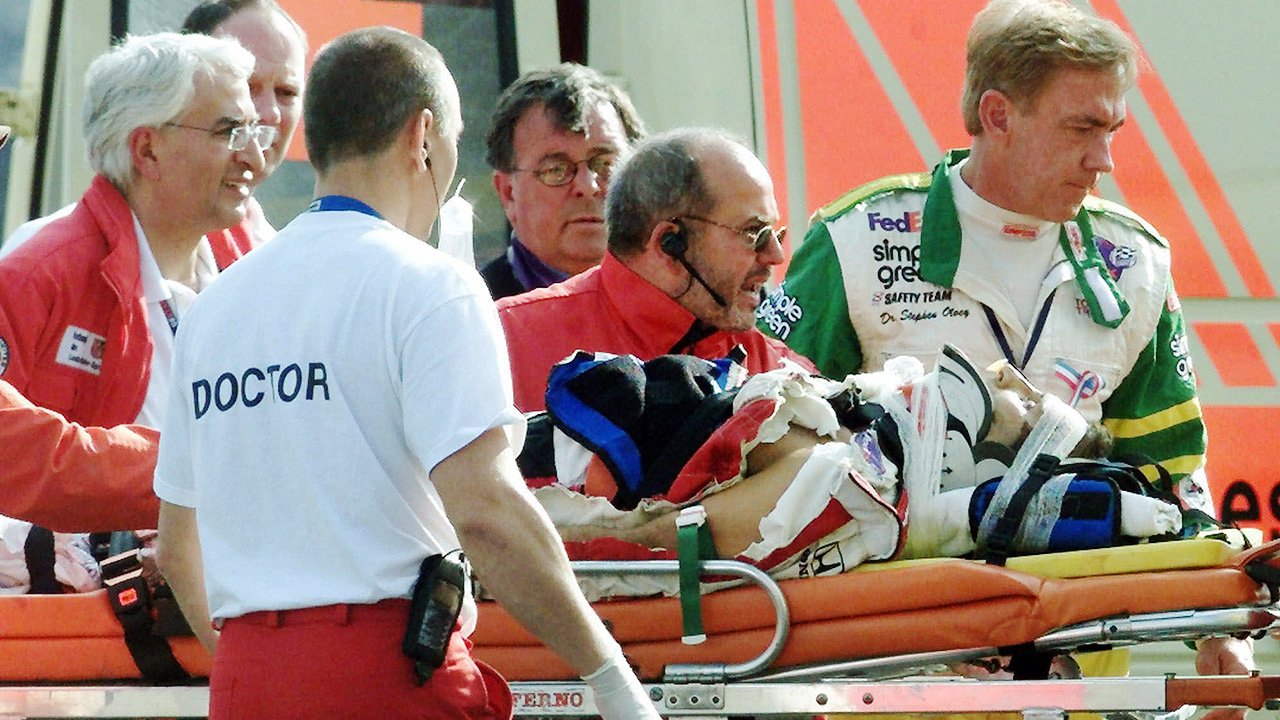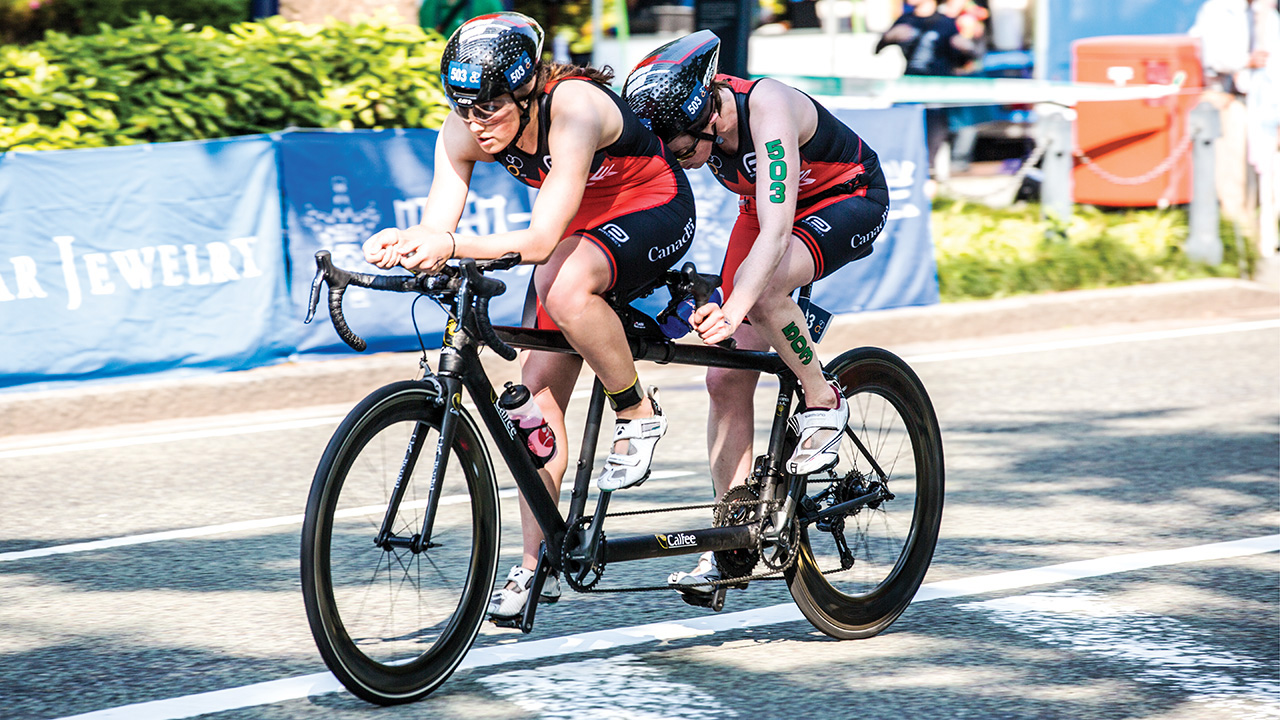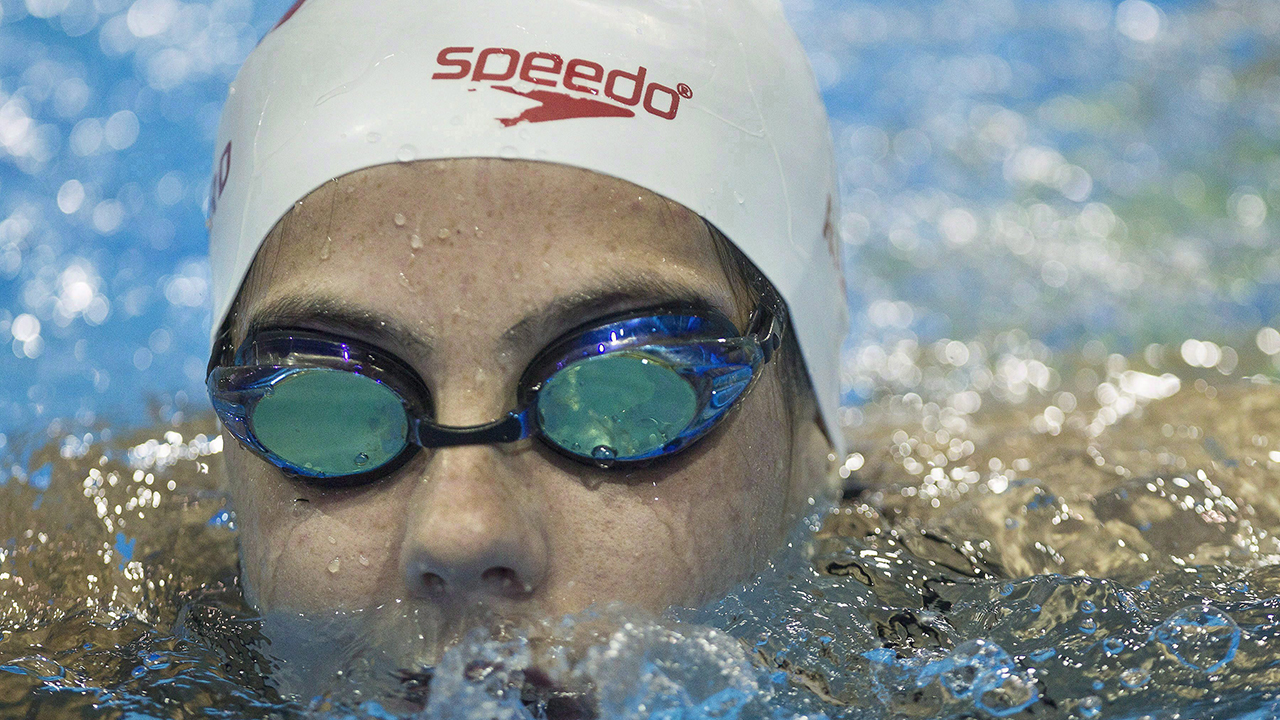Chasing Alex Zanardi was nothing new for Max Papis. The pair had been bonded like peeled rubber and asphalt since their teenage days tearing around Italian go-kart tracks. When Zanardi overtook Papis to regain the lead at the 2001 American Memorial, he gave his buddy a playful wave. In the waning moments of the CART (Championship Auto Racing Teams) race, just after Zanardi jeopardized his lead by pitting, Papis became aware of a wreck on the front stretch of the oval, an area he’d passed seconds earlier. “You could see it was a pretty big accident,” he says, “but when you’re sitting in the car you can’t really see who it is.” The race finished under caution and Papis, thrilled with his second-place result, sought out his brother, also named Alex, to celebrate. It was only then that he learned what had happened to Zanardi. “Don’t worry, Alex is strong,” Alex Papis told Max. “He’s going to make it.”

A decade and a half after Zanardi lost his legs and nearly his life at Germany’s EuroSpeedway, the 49-year-old may be experiencing one of the richest rides on the planet. On Thursday—15 years to the day after his accident, Zanardi will attempt to win a second gold medal in hand cycling at the Paralympics in Brazil. The determination required to re-invent himself was embedded in Zanardi long before his horrific crash in 2001, but the incident did coax out other attributes. The fully formed result is nearly too much to comprehend: a universally adored man whose passion is filtered through a pragmatism that took hold early on, when other traumatic events touched his family. Zanardi views his resilience more as a required characteristic than a reason to be feted, which is just as well, because the man moves too fast to linger at the centre of any parade in his honour.
Zanardi’s ability to negotiate life’s crueller offerings likely stems from a simple combination of ability and experience. The first part, of course, you’re simply born with. “In Italian, we say a peaceful heart,” Zanardi says of his disposition. The other aspect of the equation builds in people at different times in an assortment of ways. Zanardi was just 13 when his sister, 15-year-old Cristina, was killed in a car accident. Though devastating in the moment, Zanardi says he didn’t comprehend the full dimension of the loss until he became father to his only child, Niccolo, many years later. “When my son was just a kid, I remember him going for a running race at school and winning and coming to hug me,” Zanardi says. “I realized my heart was absolutely full of joy, there was no space left.”
That was the feeling Zanardi’s parents, Dino and Anna, were robbed of the day Cristina died. True healing didn’t really begin to take hold until a friend of Dino’s who ran a motorcycle shop made what initially seemed to be a misguided, even insensitive, suggestion. With Zanardi on the verge of being eligible for a scooter licence, the man told Dino he should get his son a go-kart instead. “‘Are you kidding me? That’s dangerous. No way,'” says Zanardi, relaying his father’s response. The lobby was pretty convincing, though: Instead of having your son rip around on two wheels in free-moving traffic, why not have him on four wheels on a contained track wearing a helmet? The clincher was a comment about how weekend kart races were an organic way for families to spend time together. “My dad just fell in love with the idea,” Zanardi says.
With not a trace of engine oil in the gene pool, the family—a working-class crew based outside Bologna in northern Italy—set out to conquer karting. Zanardi drove, Dino assumed the role of mechanic and Anna made sure everyone was fed, managed the tires and kept close tabs on the competition. “She would let us know at the end of the day who was faster, and where they were a little faster,” Zanardi says. The learning curve was steep for everyone, but it equipped them with the characteristic Zanardi believes eventually allowed him to pull away. “Not knowing how to do things made me put a curiosity, a lot of interest, into trying to understand why something was happening in that particular way,” he says. While many of racing’s intricacies took time to figure out, the sport’s economic burden became apparent immediately. “My dad used to say, to maintain the go-kart was like growing a pig with caviar and champagne,” Zanardi says, happy to share an example of his father’s first-rate humour.
Whatever money Zanardi could bank with kart wins, it wasn’t going to be enough to finance the next level. A spot in Formula 1’s feeder series cost about $200,000 in the 1980s. Luckily for Zanardi, he had caught the eye of somebody who could help. Cesare Papis was a busy man, so he didn’t attend all of his son’s events. But when he did, his second-favourite driver was Max’s best buddy, the guy who went all out, all the time. Though his small cotton-and-silk printing business had by no means made him rich, Cesare told Zanardi he would give him half the money required for a season in Formula 3.
“He said, ‘I think your dad turned you into a fighter, so all you need is that first possibility,'” Zanardi recalls. “‘You’re a guy who never gives up. I love the way you drive. You always try to pass the go-kart in front of you, even if you’re fighting for last place.'”
Zanardi became well-versed in battling for first spot during his initial spin on the CART circuit. He had come to the United States after failing to establish himself with lightweight F-1 teams in the early ’90s. If Cesare Papis provided a huge boost at the outset of Zanardi’s adventure, the driver’s next great professional relationship came with CART team owner Chip Ganassi. After earning rookie-of-the-year honours in 1996, Zanardi won back-to-back drivers championships the following two years. With a dozen combined wins in 1997 and ’98, Zanardi established himself as the class of the field and a fan favourite with his daring style. He was just as irresistible outside the cockpit, thanks to a broad smile, floppy hair and an Italian accent that just begged for impersonation. It was as if Zanardi simultaneously played the role of star quarterback and school mascot. The only downside was the fact Zanardi’s dad never got to witness his son’s halcyon days in the sport, having passed away in 1994 at just 54 years old from cancer. “I had him around in other great moments of my life and you have to start from that,” Zanardi says.
His North American success encouraged Zanardi to take one more F-1 rip with Williams in 1999, but the relationship lasted just a single year. Following a motorsport sabbatical in 2000, Zanardi returned to CART—this time with Mo Nunn Racing—and was chasing his first win of the year in the season’s 16th event on a dreary afternoon on Sept. 15, 2001 in Germany. (The race, originally called the German 500, had been renamed the American Memorial in honour of the terrorist attacks in New York four days prior.) After a 5.5-second stop for fuel with 13 laps to go, Zanardi headed back toward the track and, ideally, the top of the podium. While still in the pit lane, he lost control of his Honda-powered machine and slid over a patch of grass onto the course. The first car to approach belonged to Canadian Patrick Carpentier, who moved to his right and narrowly avoided Zanardi. Single-seaters are designed to absorb impact in the front and back, so when another Canadian driver, Alex Tagliani, blazed on the scene next at nearly 200 miles per hour, Zanardi—now exposed broadside, his nose facing the infield—was so prone he may as well have been out of the car walking backwards with his eyes closed. With impact unavoidable, Tagliani exploded through the front of Zanardi’s Reynard chassis like a wayward tractor-trailer through a log cabin.

The medical team was immediately on the clock. The report right after the race was that Zanardi—who lost about as much blood as you can without instantly dying—remained in critical condition, but was breathing on his own. Doctors performed hours of high-stakes surgery at a Berlin trauma centre to save his life. After about a week, with Zanardi’s condition stabilizing, Papis flew to Berlin to be with his friend. He took turns with Zanardi’s wife, Daniela, pushing Zanardi in a wheelchair. Having made a point of drawing attention to Papis’s feet, Zanardi—his right leg gone from the knee down, his left severed from the lower thigh–cracked that he’d be able to save money on shoes. “I knew this,” Papis recalls of the entire ordeal. “If he was not dead on the spot and there was a little bit of a chance for him to survive, he would.”
Physically recovering from the crash was not really an issue for Tagliani. Despite the fact he was also rushed away to the hospital, the 27-year-old was in good shape. All the same, Daniela made sure to check in on him, too. “I will always remember that,” Tagliani says. Seven days after the race in Germany, the CART series moved to England. The time-honoured “get back behind the wheel” racing mentality ensured that, because Tagliani’s body was fit to drive, he returned to the grid. His mind, however, was still hijacked by what had happened a week earlier. “I was constantly thinking about, ‘What if and why, what if and why?'” Tagliani says. “I watched the crash many times, people showed me the data, but I just wished it wasn’t me there. Even when people would tell you, ‘There’s nowhere you could go, he jumped right out in front of you,’ all the bullshit, it just doesn’t really help.”
In a sense, Zanardi’s recovery was less complicated than Tagliani’s. While the latter wrestled with emotional duress and seriously contemplated walking away from racing, the former could channel his mental energy into all the new things he had to learn. It was almost like he was back with his mom and dad, squinting at the go-kart, figuring out how to make the damn thing go faster. “The question I asked myself as soon as I woke up was not, ‘How am I going to live with no legs?'” Zanardi says, “but rather, ‘How the hell am I going to all the things I want to do with no legs?’ It was more curious and sort of a technical question rather than a spiritual and worried question.”
One of the best orthopaedic centres in the world happened to be located in Bologna, so Zanardi had no trouble detailing every minute aspect of what he was experiencing while testing out prosthetic legs. “To not only speak the same language, but the same dialect, was certainly a very big help in my rehabilitation,” Zanardi says. “To talk to people who were definitely my compatriots, my people.” That communication, coupled with painstaking devotion to his exercises, helped Zanardi accelerate through projected recovery timelines like he was back driving for Ganassi. Ten months after the incident, Zanardi returned to visit his CART family at the 2002 Molson Indy Toronto. When he crossed paths with Tagliani, all the remaining debris from their collision cleared.
“He said to me, ‘You know what, I’m about a half-inch taller with my new legs,'” Tagliani says. “I laughed and we started speaking Italian a bit. [It was] his way of making me feel good about it, the look in his eyes, there was no animosity or anything like that, so when I got [reassurance] from him, those first five seconds when I saw his face, his big smile, and he was OK and he was happy, it was like a big, massive weight on my shoulders just dropped. I was free.”

If Zanardi’s foray into motorsport was a conscious move to keep him off public roads, his entry into hand cycling can be traced back to a serendipitous decision to leave one. In 2006, Zanardi–a keen cyclist before his accident–just happened to patronize the same motorway stop as world-class hand cyclist Vittorio Podesta. “We started a conversation that has not yet ended,” Zanardi says. In 2007, Zanardi entered the New York City Marathon, more or less on a whim, and by 2009, hand cycling had become a central part of his life. He started to realize his full potential by 2011 and one year later, at the London Paralympics, Zanardi won gold in both his road race and time trial. “There is this particular moment which is like a picture in my heart,” Zanardi says. It occurred when Podesta was completing his second of two laps on the H2 handcycle course. (Competitors are grouped from H1 to H5, H1 representing the most severe impairment. Zanardi competed in H4 in London; today he competes in H5.) As he whizzed past the Italian team watching from the sideline, Podesta could have used the precious opportunity to ask for helpful info on his status and that of his opponents. But when the chance to shout presented itself, his mind went to someone else.
“He used his oxygen to say, ‘Where did Alex finish?” Zanardi recalls.
His extremely close tie to Podesta, who’s also competing in Rio, is just one of a plethora of relationships Zanardi has struck up in his new existence. Many of them, of course, are far more ephemeral, as those touched by his story—in Italy, only a handful of people are more known and celebrated than Zanardi—reach out to express how much his journey has moved them. Whatever kind of connection you’re talking about, Papis has seen a shift in his friend.
“His generosity and giving to people without expecting something in return has been something I’ve seen growing in him since his accident,” Papis says. “Usually, an accident like that can change you forever, can make you really bitter. Instead, it made him a lot sweeter. He became, for everyone else, who he always was for me.”
Preparing for Rio meant taking a year off from Zanardi’s original sporting love. His first post-crash stint behind the wheel occurred less than two years after the incident at the same speedway where he lost his legs. Driving a modified car with hand controls, Zanardi completed the laps he never got to finish in 2001. Though the action was symbolic, the pace was real; Zanardi guided the car around at speeds that would have made him a competitive qualifier for the 2003 competition. The beast was officially reawakened and in the ensuing years, Zanardi embarked on another successful chapter driving sports cars. Now, with his 50th birthday one month away, he still intends to participate in select events with BMW in the future. He’s also tackled the Ironman in Kona, Hawaii, and is quite certain there will be more in his future. “I don’t feel obliged to shoot some more fireworks in my life,” Zanardi says, “but when you have the opportunity, why shouldn’t you?”
As for the Rio Paralympics, Zanardi already has a gold in the time trials and could add another on Thursday in the road race. Should that happen, he may again experience a feeling that’s gripped him in the past. “There are many times, even to this day, where I cross a line in front of many others, I get cheered from a lot of people and I look up and I say, ‘I wish my dad and sister were here with me to celebrate,'” he says.
The good news is, Zanardi never lingers too long on dreams he can’t make a reality. And it doesn’t take much time for him to find another one he can.



